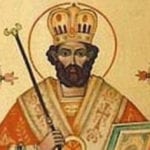 Crime
Crime  Crime
Crime  Humans
Humans 10 Unsung Figures Behind Some of History’s Most Famous Journeys
 Animals
Animals 10 Species That Refused to Go Extinct
 Weird Stuff
Weird Stuff 10 Weird Things People Used to Do at New Year’s
 Our World
Our World 10 Archaeological Discoveries of 2025 That Refined History
 Weird Stuff
Weird Stuff 10 Fascinating Facts You Might Not Know About Snow
 Miscellaneous
Miscellaneous Top 10 Things Crypto Was Supposed to Change & What Actually Did
 History
History 10 Huge Historical Events That Happened on Christmas Eve
 Music
Music 10 Surprising Origin Stories of Your Favorite Holiday Songs
 History
History 10 Less Than Jolly Events That Occurred on December 25
 Crime
Crime 10 Dark Details of Australia’s Gruesome Unsolved Wanda Murders
 Humans
Humans 10 Unsung Figures Behind Some of History’s Most Famous Journeys
 Animals
Animals 10 Species That Refused to Go Extinct
Who's Behind Listverse?

Jamie Frater
Head Editor
Jamie founded Listverse due to an insatiable desire to share fascinating, obscure, and bizarre facts. He has been a guest speaker on numerous national radio and television stations and is a five time published author.
More About Us Weird Stuff
Weird Stuff 10 Weird Things People Used to Do at New Year’s
 Our World
Our World 10 Archaeological Discoveries of 2025 That Refined History
 Weird Stuff
Weird Stuff 10 Fascinating Facts You Might Not Know About Snow
 Miscellaneous
Miscellaneous Top 10 Things Crypto Was Supposed to Change & What Actually Did
 History
History 10 Huge Historical Events That Happened on Christmas Eve
 Music
Music 10 Surprising Origin Stories of Your Favorite Holiday Songs
 History
History 10 Less Than Jolly Events That Occurred on December 25
10 Interesting Epilogues Of Historical Villians
While some of history’s heroes’ entire lives consist of well-known events, each a tile that together make the mosaic of their greatness, most are only known for a small portion of their lives. An act or role they took part in burns so bright that it permanently etches their names into the annals of history, while casting a long shadow onto the rest of their lives. For example, Rosa Parks will always be known for one Thursday in 1955.
This list is not about the heroes. This is about the other guys (and gal) and their story after their rise to infamy.
10Herod The Great

The good book is pretty unambiguous about the ancient king of Judea. The act Herod is most infamous for is The Slaughter of the Innocents. After receiving word that a baby was to be born who would become known as “king of the Jews,” King Herod ordered the massacre of all male children aged two years or younger. While this event’s historicity has been called into question in more recent years, almost all contemporary accounts describe a paranoid and duplicitous ruler.
Herod did not live long after the birth of Jesus, dying in 4 BC. Unfortunately for historians, the best record of Herod’s life came almost a century after his life, by Flavius Josephus. Josephus writes that the king’s last years were plagued by increased paranoia and ailments such as fever, convulsions, bad breath and “gangrene of the privy parts,” to name a few. In 2002, physician Jan Hirschmann of the University of Washington School of Medicine reviewed accounts of Herod’s ailments and concluded that he most likely suffered from a mix of chronic kidney disease and Fournier’s gangrene (a disease that could explain the rotting away of the king’s privates). Whether a case of bad luck or divine retribution, it was not a very regal end for a man known for opulence and control.
9Nero

Despite being thrown into the role of emperor by his parents against his wishes (he always wanted to be an actor), Nero was considered a fair and just emperor of Rome when he took the throne. This legacy did not last long, though, as Nero would go on to orchestrate the murder of his wife, mother, and many others. His rule was marked by debauchery, frivolous spending, and bad acting, once even making Roman audiences watch him perform on threat of death. Perhaps the act Nero is most well known for is fiddling while Rome burned in AD 64. Despite the fiddle not even existing in Rome at this time and Nero’s quick response to help those displaced, his reputation never recovered after the fire.
Quick to deflect blame, Nero pointed a finger at Christians, still a fledging movement in Rome. Despite his best attempts, Nero was not able to divert all attention off his own avarice, especially when he took advantage of the land freed up by the Great Fire to build himself a golden palace. Nero was spending his time quashing revolt after revolt until his own Guard abandoned him at his palace. Knowing the end was near, Nero decided to commit suicide but was unable to go through with the act himself. His secretary helped him run himself through with a sword. Ever the poet, his last words were “What an artist the world loses in me!”
8Genghis Khan

Few individuals, if any, have had as big of an impact on the world as Genghis Khan. Leading the Mongol Hordes, he killed so many people that he effectively lowered the amount of greenhouse gases from the atmosphere. On top of this, he also personally had so many children that there is a 0.5 percent chance that anyone reading this article is a direct descendent of him.
Reports of Genghis Khan in old age describe him as superstitious and relying strongly upon omens interpreted by his shaman. Wishing to live forever, his forces scoured the empire for a 71-year-old Chinese-Taoist alchemist who was believed to have created an elixir of immortality. While he did find the elixir, it didn’t work as advertised, and the emperor died at in 1227 at the age of 60.
While most great emperors’ burial sites are marked by enormous monuments built in their name, Genghis Khan was more concerned about grave robbers. The funeral procession traveled several weeks to a secret location. The soldiers in the procession killed anyone they passed along their way. His burial site was then trampled by 1,000 horses so it could not be found, and for extra measure, all the soldiers involved in the burial were also executed. While there are a few educated guesses, the actual site of Genghis Khan’s burial remains a mystery to this day.
7Christopher Columbus

Christopher Columbus is an interesting historical figure, as his character and accomplishments have fallen under review in recent years. While he was traditionally considered an ambitious explorer who discovered America, a more accurate portrait paints a violent businessman who never even landed in what is now known as America but rather landed in the Bahamas.
As a thank you for his discovery, Columbus was named governor and viceroy of the Indies by the Spanish crown. With this title, he led a reign of violence and terror over the islands. One man who stole corn had his ears and nose cut off. Violence against natives ran rampant under his rule. After a 48-page document written by both Columbus’s enemies and friends thoroughly detailing his cruelty was sent back to Spain, he was stripped of his titles and charged with “tyranny.”
Disgraced but still fairly wealthy, Columbus spent the rest of his days in Spain, growing more and more religious in old age. Before his death by gout at age 54, he wrote two separate books. Book of Privileges detailed everything he believed he was owed by the crown for his discovery, while Book of Prophecies described how Columbus believed himself to be doing God’s work and his discovery of the New World was fulfilling biblical prophecy.
6‘Bloody Mary’ I Of England

One of the most powerful women in Western history and the only leader to earn the moniker of “Bloody,” Mary I of England is probably most invoked today by children at slumber parties hoping to catch the glimpse of a murderous specter in their bathroom mirror. The real Bloody Mary is a perhaps much more frightening character, inheriting the British Empire in 1553 after her father, King Henry VIII’s only son died at the age of 15. Strongly opposed to her father and his Anglican ways, Mary vowed to return England to its Catholic ways. What followed was one of the darkest reigns in English history as hundreds of Protestants and opponents to the crown were openly burned at stakes.
Despite being a powerful ruler, Mary was unable to avoid one of the most important duties of noblewomen of the age—producing an heir. Desperately in love with her husband Philip II of Spain and fearing her sister Elizabeth taking the throne, Mary was determined to have a child. After two failed pregnancies, Mary cautiously believed she was finally pregnant, showing classic signs such as nausea, a lack of periods, and even a growing baby bump. Months passed, her stomach grew, but her due date came and passed. As time went on, the belly bump receded again, leaving a disappointed and childless Mary. Months later, she died from complications from the flu at the age of 42. Records of an autopsy done at the time lead some modern physicians to believe that this “phantom pregnancy” may be caused by an ovarian cyst, possibly cancerous. This may also have contributed to the complications leading to the queen’s early demise.
5Benedict Arnold

Benedict Arnold’s story is one of ambition and duplicity. Suffering a leg injury from an early battle and bitter from believing he was not getting the recognition he deserved within the Continental Army, Arnold switched sides to the British, bringing valuable military information with him.
Unfortunately for Arnold, he never received the prominence he expected. Although the British army was thankful for his intelligence, he was never fully trusted nor able to shake the reputation of a turncoat. Following the British defeat, he moved his family to England before opening a trading post with his brother in New Brunswick, Canada. Failed business ventures and minor lawsuits resulted in an angry mob burning his likeness in effigy on his front lawn as his wife and children watched in terror. After dying of gout in 1801, Arnold’s bad luck did not end in death. Due to clerical error, when the church holding Arnold’s remains was renovated, his body was moved to an unmarked grave. A poetic ending for a man who spent his whole life trying and failing to find recognition and glory.
4Robert E. Lee

Although initially opposing secession himself, General Robert E Lee became the leading figure of the Confederate Army against the Union, leading many successful battles and acting as key mastermind behind many Southern victories. Despite his surrender at Appomattox Court House in 1865, it was decided that Lee still had to pay for his role in rebelling against the United States.
President Johnson pardoned most Confederate soldiers following the war, but Lee had to write a personal plea to Johnson requesting amnesty and reinstatement of citizenship. Multiple letters were ignored for three years before a more general order granted him his pardon. To add insult to injury, his family home was confiscated by the federal government and is known today as Arlington Cemetery, holding the graves of thousands of Union soldiers.
From 1865 until his death (by stroke), Lee served as president of Washington College (now Washington and Lee). It was while here that he was recorded saying that his greatest mistake in life was taking a military education.
3Al Capone

The Kingpin of Chicago, Capone kept the booze, gambling, and women rolling in during Prohibition and was willing to kill anyone who got in his way. Running a multi-million-dollar enterprise, Capone was the face of organized crime. Over 300 people died on Capone’s orders, the most infamous case being the Valentine’s Day Massacre. While most know he was brought down due to tax evasion, this was not the end of his criminal ways.
After failing to bribe the jury, Capone was found guilty and sent down to a federal penitentiary in Atlanta. While not the Ritz-Carlton, it was far from the punishment most believed Scarface deserved. Capone was able to bring in a nice bed, furniture, plants, and would spend hours with the guards listening to serials on his own personal radio. He would also host multiple visitors every day, so it’s believed he continued to run his organization from behind bars. After two years, Capone was moved to Alcatraz where he was not allowed the same creature comforts.
No longer given preferential treatment, Capone was still allowed one request—to start a prison band. Capone filled his later years learning over 500 songs on tenor guitar and banjo. He even wrote a love song for his wife, “Madonna Mia.”
2Josef Mengele

Working as an experimental doctor in Auschwitz, Josef Mengele, the Angel of Death, carried out some of the most atrocious acts in one of the evilest places in the world. For scientific study, Mengele performed countless inhumane experiments on children from dissection and injections to testing the limits of the human body before death and many more that cannot all be named here. He was especially interested in twins, experimenting on one subject and using the other as a control.
As the Nazis fell, Mengele was captured by American soldiers but was quickly let go due to lack of evidence. As his colleagues faced trial in Nuremburg and began to reveal some of the experiments carried out under the doctor, Mengele lay low, working as a farmhand. In 1949, he was able to jump ship to Argentina, a country notoriously known for its leniency to former Nazis. Here, Mengele worked odd jobs under various names. Staying one step ahead of Nazi hunters and the Mossad, he moved first to Paraguay and then Brazil. While swimming off the Brazilian coast in 1979, Mengele suffered a stroke and drowned. Buried under a false name, his identity was not confirmed until his body was exhumed in the mid-1980s.
A town near where Mengele lived in Brazil is known today for its unusually high number of twins. Whether Mengele is behind this phenomenon or it is what drew him to this area in the first place is unknown.
1General Butt Naked

While the only one on this list who is still alive, General Butt Naked, a.k.a. Joshua Blahyi, is definitely worthy of an epilogue.
In the early 1990s, Blahyi led rebel troops (mostly child soldiers) in the First Liberian Civil War. He earned his interesting nickname by often entering battle in nothing other than shoes and holding a gun, believing it would grant himself immunity to enemy bullets. He was also known to take part in child sacrifice and cannibalism in the devil’s name before battle.
As the war came to an end in 1996, the general befriended a local bishop who helped him seek forgiveness for his horrible actions. Converting to Christianity, Blahyi found that he could use his natural ability to lead soldiers into battle to lead a congregation as a pastor. He has since told Reuters, “The country we destroyed is the country we want to rebuild”
Blahyi has founded the charity “Journey against Violence,” which has trained over 1,000 former soldiers in important job skills such as bricklaying and farming.
Despite lacking his own evil backstory, Henry Cain still hopes to help make a positive difference in the world, spending his time volunteering, writing, and exploring California.








